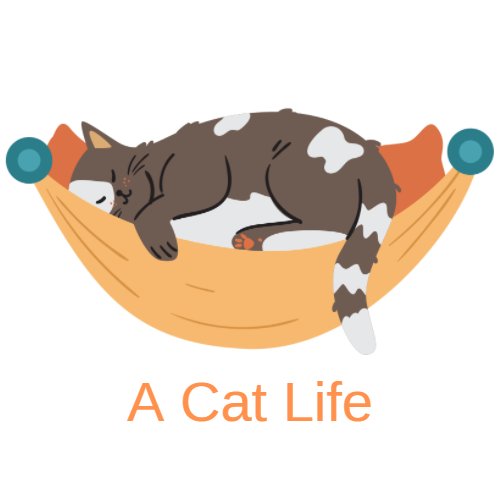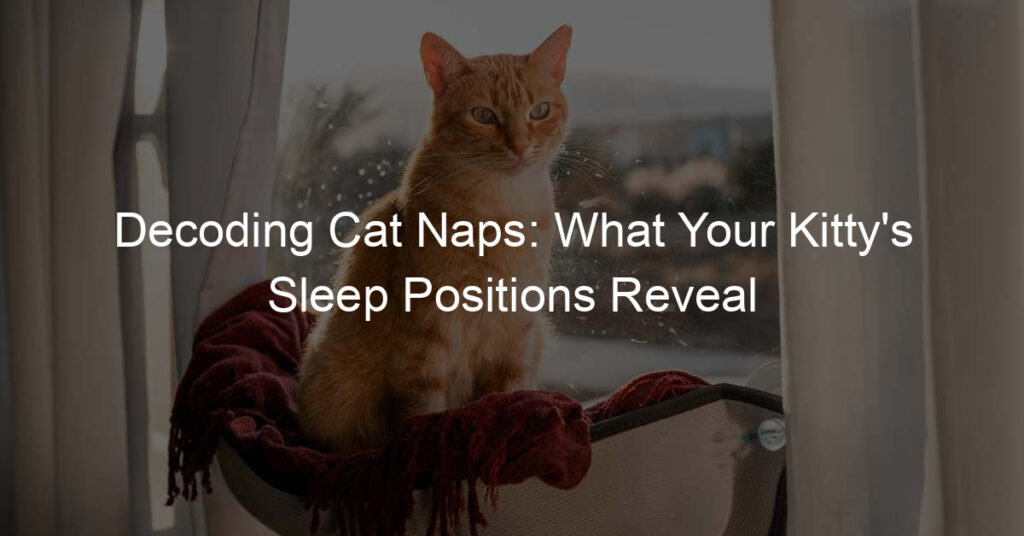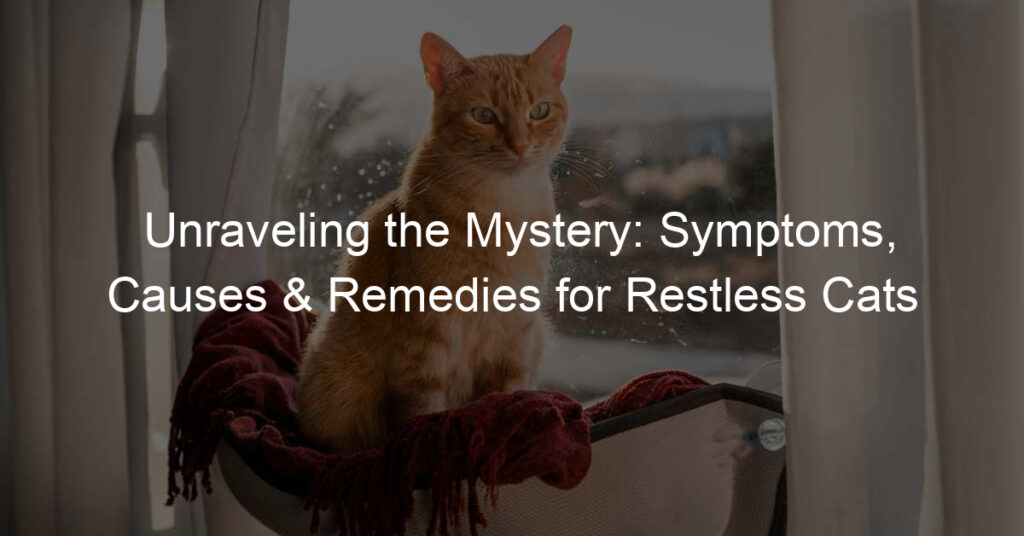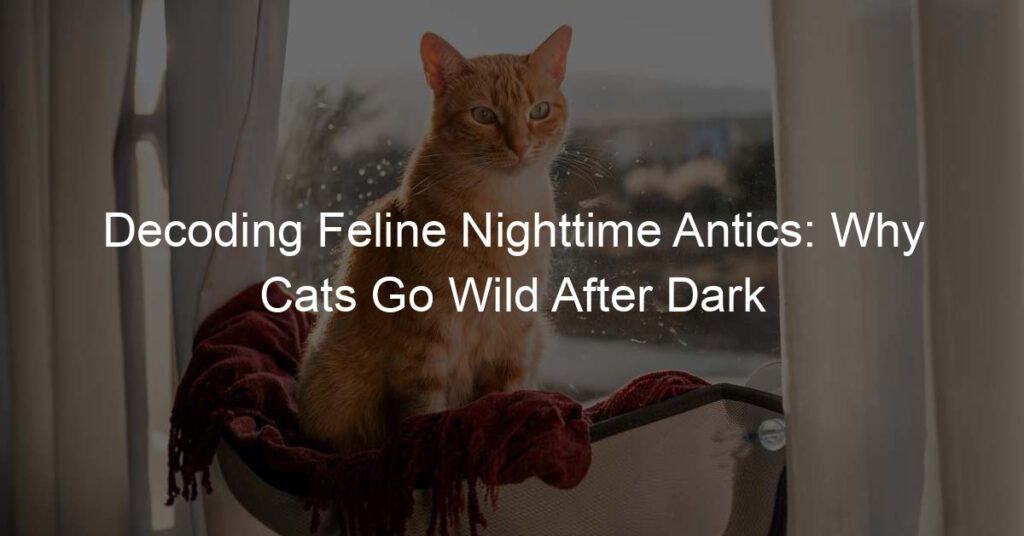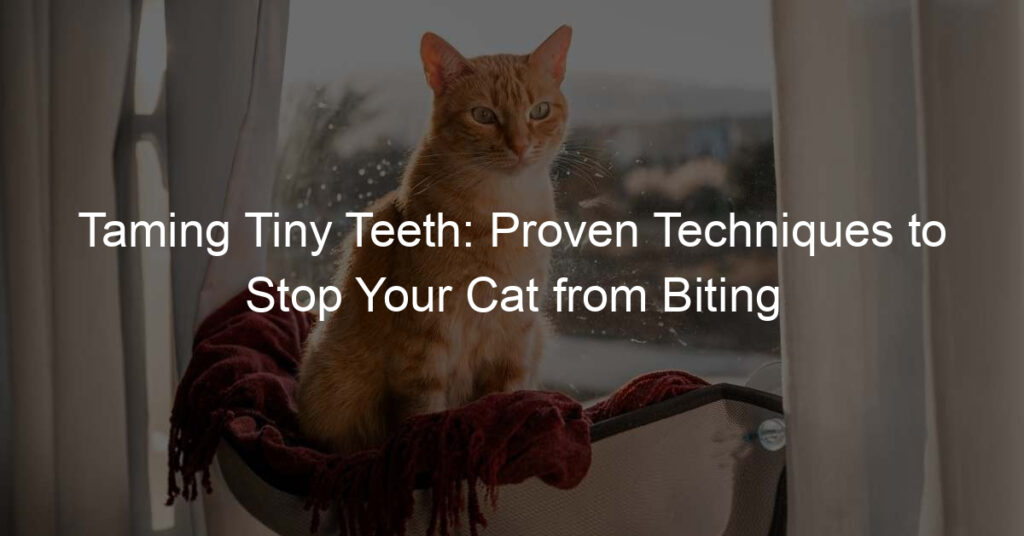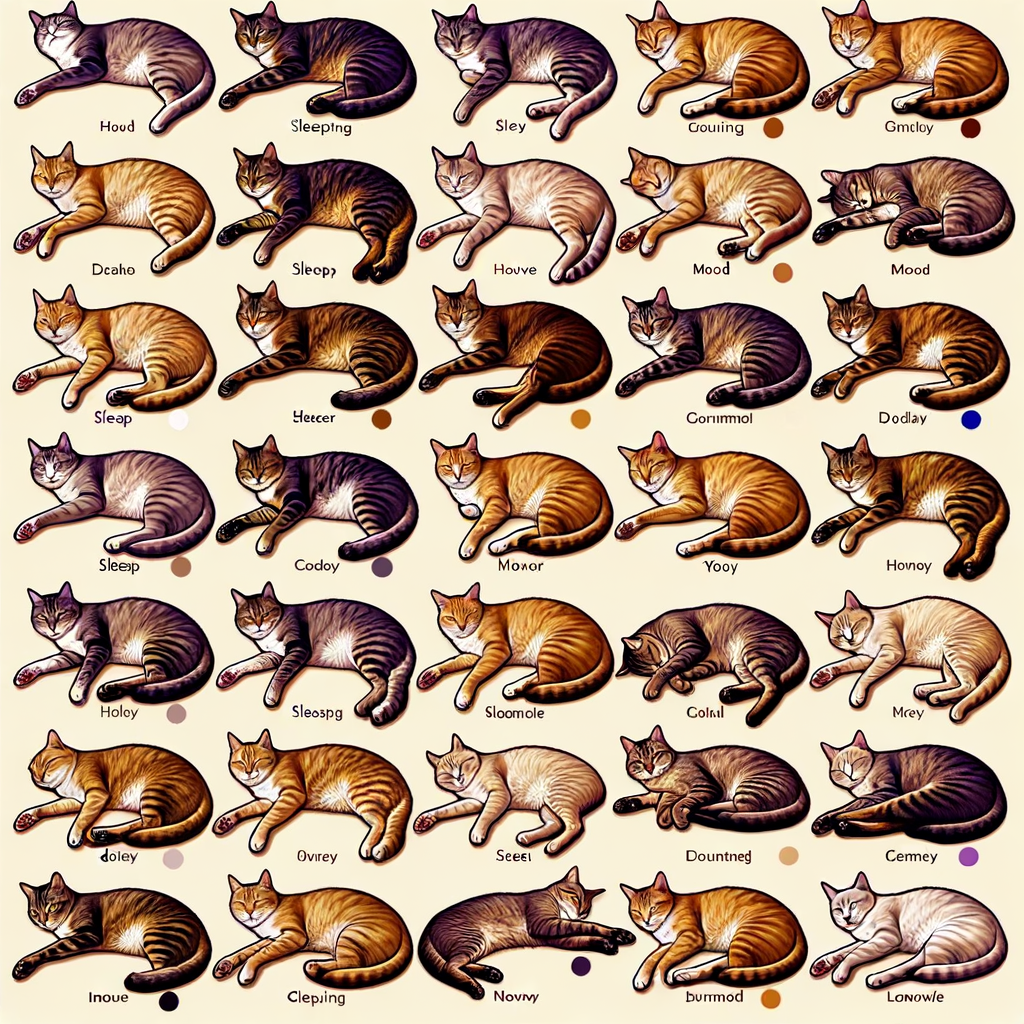
Introduction: Understanding Cat Sleeping Positions
Have you ever wondered why your feline friend sleeps in a certain way? Cats, like humans, have different sleeping positions. These positions can tell us a lot about their mood and health. In this article, we will delve into the fascinating world of cat sleeping positions and what they mean.
- Importance of observing cat sleeping positions
- How cat sleeping positions can reveal their mood and health
Observing your cat’s sleeping positions is not just about satisfying your curiosity. It can provide valuable insights into their comfort, mood, and overall health. Cats are known for their ability to hide discomfort or illness, so their sleeping positions can be a subtle clue for pet owners. For instance, a cat that usually sleeps curled up but suddenly starts sleeping stretched out may be experiencing discomfort or pain.
Cat sleeping positions can be a window into their emotional and physical state. For example, a cat that sleeps on its back with its belly exposed is likely feeling secure and content. This is because exposing the belly is a vulnerable position, so a cat will only do this when it feels safe. On the other hand, a cat that sleeps curled up tightly may be trying to conserve heat, indicating that it may not be feeling well. Similarly, changes in sleeping positions can also indicate changes in health. If your cat suddenly starts sleeping in a new position, it may be worth a trip to the vet.
In the following sections, we will explore different cat sleeping positions in more detail, providing you with the knowledge to better understand and care for your feline friend.
Decoding Cat Sleeping Positions and Their Mood
Understanding your cat’s sleeping positions can offer a wealth of insight into their mood and overall well-being. One common position is the classic cat nap, where your feline friend curls up into a little ball. Let’s explore this position in more detail.
Curled Up: The Classic Cat Nap
When your cat curls up into a ball, it’s often a sign they’re settling in for a good sleep. This position, known as the classic cat nap, is a favorite among many felines. But what does it mean, and what can it tell us about your cat’s mood?
- Meaning behind this common cat sleeping position: The curled up position is a natural instinct for cats. It helps them conserve body heat and protect their vital organs while they sleep. In the wild, this position also helps cats protect themselves from predators. When your cat curls up, it’s a sign they feel safe and secure in their environment.
- What it indicates about your cat’s mood: If your cat often sleeps in the curled up position, it’s a good sign they’re feeling relaxed and content. This position allows cats to rest deeply, so if your cat often curls up, it’s likely they’re feeling quite comfortable in their home. However, if your cat is always curled up and doesn’t show much activity when awake, it might be a sign of stress or illness. Always keep an eye on your cat’s behavior and consult with a vet if you notice any drastic changes.
Understanding your cat’s sleeping positions can help you better understand their mood and overall well-being. By paying attention to these small details, you can ensure your feline friend is happy, healthy, and comfortable in their home.
The Belly Up: A Sign of Trust
One of the most endearing sights for a cat owner is when their feline friend sleeps belly up. This position, while seemingly vulnerable, is a significant indicator of the level of trust and comfort your cat feels around you.
- Understanding this vulnerable cat sleeping position
- What it reveals about your cat’s trust and comfort level
When a cat sleeps belly up, it exposes its most sensitive areas, including the stomach and throat. In the wild, this would be a risky move, as it leaves them open to attacks from predators. However, in the safety of your home, this position signifies that your cat feels secure and protected.
Seeing your cat in this position can be a heartwarming moment. It is a clear sign that your cat trusts you and feels comfortable in your presence. Cats are naturally cautious creatures, so this level of trust is a testament to the bond you share with your pet.
It’s important to respect this trust. If your cat is sleeping belly up, resist the urge to pet their exposed belly. While it might be tempting, remember that this is a vulnerable position for them. Disturbing them could lead to them feeling unsafe and less likely to assume this position in the future.
| Cat Sleeping Position | What It Indicates |
|---|---|
| The Belly Up | Trust and Comfort |
In conclusion, the belly up sleeping position is a clear sign of trust and comfort. It shows that your cat feels safe and secure in your home. As a cat owner, it’s your responsibility to nurture this trust and ensure your pet continues to feel safe and loved.
The Loaf: Alert and Ready
One of the most intriguing cat sleeping positions is the “Loaf” position. This position is unique and offers valuable insights into your cat’s alertness and readiness. Let’s delve into understanding this position better.
- Interpreting this unique cat sleeping position
- What it suggests about your cat’s alertness and readiness
In the Loaf position, your cat tucks its paws under its body, resembling a loaf of bread. This position is not just adorable but also quite informative. Unlike the other sleeping positions, where the cat is fully relaxed, the Loaf position suggests a state of semi-alertness. Even while resting, your cat is ready to spring into action if needed.
The Loaf position is a clear indicator of your cat’s alertness and readiness. Cats in this position are often attentive to their surroundings. They can quickly transition from a state of rest to action, showcasing their agility and readiness. This position is common in environments where the cat feels safe but still needs to be alert for potential threats or unexpected events.
Understanding your cat’s sleeping positions can help you better understand their mood and behavior. The Loaf position, with its unique blend of rest and readiness, is a testament to the fascinating world of feline behavior.
| Cat Sleeping Position | Interpretation |
|---|---|
| The Loaf | Indicates alertness and readiness. The cat is resting but ready to spring into action. |
Cat Behavior Interpretation: Beyond Sleeping Positions
While understanding cat sleeping positions can give us a glimpse into their mood and health, there’s more to cat behavior interpretation. Let’s delve deeper into understanding cat body language.
Understanding Cat Body Language
Cats communicate not only through meows and purrs but also through their body language. By observing their tail, ears, and eyes, we can gain a better understanding of what they’re trying to tell us.
- Reading your cat’s tail signals
- Interpreting your cat’s ear positions
- Decoding your cat’s eye expressions
The tail of a cat is like a mood barometer. A high, straight-up tail often signifies a happy and confident cat. On the other hand, a tail tucked between the legs indicates fear or submission. If your cat’s tail is puffed up, it might be a sign that they are scared or agitated.
Cat ears are incredibly expressive. Forward-facing ears suggest that your cat is content or curious. If the ears are flat against the head, it’s a sign of fear, anger, or aggression. Ears that are slightly back can indicate that your cat is feeling playful or is slightly irritated.
A cat’s eyes can tell a lot about their mood. Slow blinking can be a sign of trust and affection. Wide, dilated pupils can indicate excitement, fear, or aggression. On the other hand, narrowed or squinted eyes may suggest that your cat is content or possibly experiencing pain.
Remember, every cat is unique and may express themselves differently. The key is to spend time with your cat and learn their individual body language cues. This will help you understand their needs and emotions better, leading to a stronger bond between you and your feline friend.
Recognizing Cat Mood Signs
Just like humans, cats have a wide range of emotions and moods. Understanding these signs can help you better care for your feline friend. Let’s explore some of the common mood signs in cats.
- Signs of a Happy and Content Cat
- A relaxed tail: A cat’s tail can tell you a lot about their mood. If it’s relaxed and still, your cat is likely content.
- Purring: This is a clear sign of a happy cat. Cats purr when they’re comfortable and content.
- Slow blinking: Cats slow blink at humans they trust and feel comfortable with. It’s a sign of affection and contentment.
- Indicators of a Stressed or Anxious Cat
- Hiding: Cats often hide when they’re stressed or anxious. If your cat is hiding more than usual, it could be a sign of stress.
- Over-grooming: Cats groom themselves to calm down. If your cat is grooming excessively, it could be a sign of anxiety.
- Changes in eating habits: Cats may eat less or more when they’re stressed or anxious. Keep an eye on your cat’s eating habits.
- Warning Signs of an Unwell Cat
- Changes in behavior: If your cat is acting out of character, it could be a sign they’re not feeling well.
- Loss of appetite: If your cat is not eating, it could be a sign of illness.
- Vomiting or diarrhea: These can be signs of a serious health issue and should be addressed immediately.
A happy cat is a joy to be around. Here are some signs to look out for:
Stress and anxiety can have a negative impact on your cat’s health. Here are some signs to look out for:
It’s important to recognize the signs of an unwell cat so you can seek veterinary help early. Here are some warning signs:
Remember, every cat is unique and may show different signs. Always consult with a vet if you’re concerned about your cat’s mood or health.
Understanding Cat Sleep Patterns
Just like humans, cats have their own unique sleep patterns. Understanding these patterns can help you better care for your feline friend. In this section, we will explore typical cat sleep patterns and what they mean, and how changes in these patterns can indicate health issues.
- Typical cat sleep patterns and what they mean
- How changes in sleep patterns can indicate health issues
Cats are known for their love of sleep. On average, a cat sleeps for about 13 to 14 hours a day. This sleep is split into two types: light sleep and deep sleep. During light sleep, your cat might twitch, move, or even “chase” things in their dreams. Deep sleep, on the other hand, is when your cat is completely relaxed and still.
But why do cats sleep so much? It’s all about survival. In the wild, cats need to hunt to eat, and hunting requires a lot of energy. By sleeping so much, cats conserve their energy for hunting.
So, if your cat is sleeping a lot, don’t worry! It’s completely normal. However, there are some changes in sleep patterns that might indicate a problem.
While it’s normal for cats to sleep a lot, changes in your cat’s sleep patterns could be a sign of a health issue. For example, if your cat is sleeping more than usual, it could be a sign of illness. On the other hand, if your cat is sleeping less than usual, it could be due to stress or anxiety.
Other changes to watch out for include difficulty falling asleep, restlessness during sleep, or changes in your cat’s sleep position. If you notice any of these changes, it’s a good idea to consult with your vet.
In conclusion, understanding your cat’s sleep patterns can help you ensure they are healthy and happy. Remember, a change in sleep patterns doesn’t always mean there’s a problem, but it’s always better to be safe than sorry. If you’re ever in doubt, don’t hesitate to reach out to a vet.
Conclusion: Interpreting Cat Sleeping Habits for Better Care
Understanding the sleeping habits of your cat is not just a fascinating study, it’s also a key part of providing the best possible care for your feline friend. By interpreting these habits, you can ensure your cat is healthy, happy, and comfortable.
- Importance of understanding your cat’s sleeping habits
- How this knowledge can help you provide better care for your cat
Cats spend a significant portion of their lives sleeping – on average, they sleep for about 13 to 14 hours a day! This is why it’s crucial to understand their sleeping habits. It can tell you a lot about their overall health and wellbeing. For instance, changes in a cat’s sleep pattern can be a sign of stress, illness, or discomfort. If your cat is sleeping more or less than usual, it might be time to visit the vet.
Knowing your cat’s normal sleeping habits can help you provide better care in several ways. If you notice any sudden changes, you can take action quickly, potentially preventing a minor issue from becoming a major problem. Understanding your cat’s sleep patterns can also help you create a more comfortable environment for them. For example, if your cat prefers to sleep in high places, you might consider getting a cat tree. If they like to sleep in the sun, make sure they have access to a sunny spot during the day.
In conclusion, understanding and interpreting your cat’s sleeping habits is an essential part of being a responsible and caring cat owner. It allows you to provide the best possible care for your feline friend, ensuring they lead a healthy and happy life.
